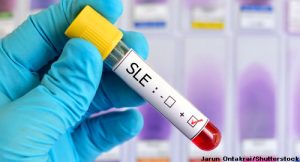 As the name implies, systemic lupus erythematosus (SLE) presents as a systemic disease, but it may also present in an organ-limited/dominant form. This variability makes early disease especially difficult to diagnose, and delayed diagnosis can lead to organ damage and is associated with increased mortality.
As the name implies, systemic lupus erythematosus (SLE) presents as a systemic disease, but it may also present in an organ-limited/dominant form. This variability makes early disease especially difficult to diagnose, and delayed diagnosis can lead to organ damage and is associated with increased mortality.
In many cases, diagnosis occurs because clinicians focus on the presence of a few high-yield clinical and immunologic symptoms, such as a malar rash in an individual with anti-DNA autoantibodies, that can be used in routine practice to clinically diagnose patients with SLE with high sensitivity and specificity.
Christina Adamichou, a graduate student at the University of Crete School of Medicine, Greece, and colleagues hypothesized that it may be possible to train machine learning-based tools with medical data to simulate the medical reasoning that occurs in successful diagnosis of SLE. To do this, Adamichou et al. developed and validated a new algorithm that uses classical disease features to help clinicians diagnose SLE earlier in the disease process. They describe their SLE Risk Probability Index (SLERPI) in an article published online Feb. 10 in the Annals of Rheumatic Diseases.1
“This is a novel approach to address the issue of accurately and timely diagnosis of SLE,” says Sarfaraz Hasni, MD, director of Lupus Clinical Research at the National Institute of Arthritis and Musculoskeletal and Skin Diseases at the National Institutes of Health in Bethesda, Md. “On average, SLE patients visit up to three providers, and it may take up to two years or more before they are diagnosed with SLE. This [delay] is even worse for women of color, who are disproportionality affected by more severe SLE.”
To create SLERPI, the researchers leveraged well-characterized data from the medical records of two large discovery and validation patient cohorts from two centers that maintained detailed patient registries and used structured forms for collecting clinical data. The investigators mined these data for features that could be combined with the 2019 European League Against Rheumatism (EULAR)/ACR SLE Classification Criteria to enhance diagnostic accuracy.2 Although intended to be used for research—not diagnostic—purposes, these criteria have a high degree of accuracy. The researchers identified well-defined features of SLE that were not part of the classification criteria, which they combined with the published classification criteria. They found thrombocytopenia/autoimmune hemolytic anemia (AIHA), malar rash, proteinuria, anti-nuclear antibodies (ANA), immunological disorder and combined C3 and C4 hypocomplementemia were the strongest predictors against competing rheumatological diseases. These 14 variably weighed clinical and serological features were used to train the new Lease Absolute Shrinkage and Selection Operator-logistic regression (LASSO-LR) model.
